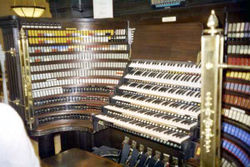This article needs additional citations for verification. (October 2009) |

The pipe organ is played from an area called the console or keydesk, which holds the manuals (keyboards), pedals, and stop controls. In electric-action organs, the console is often movable. This allows for greater flexibility in placement of the console for various activities. Some very large organs, such as the van den Heuvel organ at the Church of St. Eustache in Paris, have more than one console, enabling the organ to be played from several locations depending on the nature of the performance.
Controls at the console called stops select which ranks of pipes are used. These controls are generally either draw knobs (or stop knobs), which engage the stops when pulled out from the console; stop tablets (or tilting tablets) which are hinged at their far end; or rocker-tablets, which rock up and down on a central axle.
Different combinations of stops change the timbre of the instrument considerably. The selection of stops is called the registration. On modern organs, the registration can be changed instantaneously with the aid of a combination action, usually featuring pistons. Pistons are buttons that can be pressed by the organist to change registrations; they are generally found between the manuals or above the pedalboard.[1] In the latter case they are called toe studs or toe pistons (as opposed to thumb pistons). Most large organs have both preset and programmable pistons, with some of the couplers repeated for convenience as pistons and toe studs. Programmable pistons allow comprehensive and rapid control over changes in registration.[1]
Newer organs in the 2000s may have multiple levels of solid-state memory, allowing each piston to be programmed more than once. This allows more than one organist to store their own registrations. Many newer consoles also feature MIDI, which allows the organist to record performances. It also allows an external keyboard to be plugged in, which assists in tuning and maintenance.
- ^ a b Davis, Roger E. (1985). The organists' manual : technical studies and selected compositions for the organ (1st ed.). New York: W.W. Norton. pp. 185–190. ISBN 978-0-393-95461-6. OCLC 15081788.